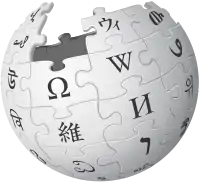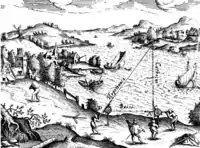triangulation
English
WOTD – 3 March 2019
Etymology
From Medieval Latin triangulātiōnem (“triangulation”), from triangulāre (“to triangulate”) + -tiōnem (suffix forming nouns relating to some actions or the results of actions). Triangulāre is derived from triangulāris (“triangular”), from triangulus (“triangular; triangle”), from trēs (“three”) + angulus (“angle; corner”). The English word is analysable as triangulate + -ion, and is cognate with French triangulation.[1]
Pronunciation
- (Received Pronunciation) IPA(key): /tɹʌɪaŋɡjʊˈleɪʃn̩/
- (General American) IPA(key): /ˌtɹaɪˌæŋɡjəˈleɪʃən/
Audio (AU) (file) - Rhymes: -eɪʃən
- Hyphenation: tri‧an‧gu‧lat‧ion
Noun
triangulation (countable and uncountable, plural triangulations)
- (uncountable, surveying) A technique in which distances and directions are estimated from an accurately measured baseline and the principles of trigonometry; (countable) an instance of the use of this technique.
- 1839 June 14, T. B. Jervis, “IV. Some Account of the Progress of the Trigonometrical Survey Now Carrying On in India. Extracted from the Correspondence of Colonel Everest, and Communicated by Major T. B. Jervis.”, in Monthly Notices of the Royal Astronomical Society, […], volume IV, number 24, London: Printed by Moyes and Barclay, […], OCLC 637567819, page 208:
- The season of 1835–36 was employed in carrying on the triangulation; in which Colonel [George] Everest was much impeded by a long continuance of hazy and cloudy weather. It appears, however, that the principal triangulation was brought down to the line from Juktipura to Pagara; […]
- 1843 February 9, John B. Aycrigg, “Notes”, in Report of John B. Aycrigg, (Made to the House of Representatives on the 9th February, 1843,) Submitted as an Individual Member of the Committee on the Coast Survey, […] (Report No. 170), Washington, D.C.: Printed at the National Intelligencer Office, published 19 February 1843, OCLC 31085054, note 19, pages 32–33:
- Russia began under Catherine II, and has since constantly either taken up at different points or extended the triangulations successively made, with always more perfection of men of science. Now, these triangulations form a fully connected series from north of the arctic circle to south of Dorpat.
- 1849 January–March, “Stated Meeting, January 19”, in Proceedings of the American Philosophical Society, […], volume V, number 42, Philadelphia, Pa.: Published for the [American Philosophical] Society, [b]y John C. Clark, […], published 1854, ISSN 0003-049X, OCLC 299393900, pages 57–58:
- The original base lines, which form the starting points of the survey, require to be measured by apparatus of the most delicate nature, since any error, committed in the early part of this work, will necessarily be multiplied throughout the series of triangulations which rest upon it. […] Nor is less precision necessary in the measurement of the angles of the primary and secondary triangulations, which serve as checks upon each other, since the position of any point in the former is determined by each of these series.
-
- (countable, surveying) The network of triangles so obtained, that are the basis of a chart or map.
- 1860 November 29, Henry James, “Appendix. [Official Correspondence, Letter C.]”, in Extension of the Triangulation of the Ordnance Survey into France and Belgium […], London: Printed by George Edward Eyre and William Spottiswoode, […], for Her Majesty’s Stationery Office, published 1863, OCLC 913570822, paragraphs 1–2, pages 57–58:
- […] I have placed myself in communication with the Astronomer Royal, for the purpose of considering the steps necessary to be taken to effect the connexion required, between the triangulation of Great Britain and that of Belgium. […] I have also placed myself in communication with General Nerenburger, Director of the Dêpot de la Guerre at Brussels, and have received from him the diagram of the Belgian triangulation, with descriptions of the stations with which it is necessary to connect our triangulation, and we possess a copy of the triangulation of France.
-
- (countable, chess) A delaying move in which the king moves in a triangular path to force the advance of a pawn.
- 1961, Gerald Abrahams, “Kings and Ascending Pawns”, in Technique in Chess, London: G[eorge] Bell and Sons, OCLC 936938891; republished New York, N.Y.: Dover Publications, 1973, →ISBN, pages 76 and 77:
- [page 76] At this point, it may be useful to refer to a word that has been used in connection with earlier examples. The King has been said to indulge in a process called Triangulation. The word is harder than the idea. The basic fact is that the King can move to an adjacent square in one move, two moves or three moves, without returning to its point of origin. […] [page 77] This diagram […] shows a position where the triangulation is vital.
-
- (countable, geometry) A subdivision of a planar object into triangles, and by extension the subdivision of a higher-dimension geometric object into simplices.
- 2002 March, Francisco Santos, “Triangulations of Oriented Matroids”, in Memoirs of the American Mathematical Society, volume 156, number 741, Providence, R.I.: American Mathematical Society, ISSN 0065-9266, OCLC 1066893094, chapter 5 (Lifting Triangulations), page 59:
- Regular triangulations are a class in-between lifting and lexicographic triangulations. Their main draw-back in the context of this paper is that regularity depends on the specific realization and not only on the oriented matroid.
- 2010, Jésus A[ntonio] De Loera; Jörg Rambau; Francisco Santos, “Triangulations in Mathematics”, in Triangulations: Structures for Algorithms and Applications (Algorithms and Computation in Mathematics; 25), Heidelberg; Dordrecht: Springer Verlag, DOI:, →ISBN, ISSN 1431-1550, definition 1.0.1, page 1:
- A triangulation of a point configuration is a collection of d-simplices all of whose vertices are points in that satisfies the following two properties: 1. The union of all these simplices equals conv . (Union Property) 2. Any pair of these simplices intersects in a common face (possibly empty). (Intersection Property)
-
- (uncountable, navigation, seismology) A process by which an unknown location is found using three known distances from known locations.
- 1958 November–December, “News Notes: Army Weather Radar Tracks Nuclear Clouds”, in William H. Zierdt Jr., editor, Armor: The Magazine of Mobile Warfare, volume LXVII, number 6, Washington, D.C.: United States Armor Association, ISSN 0004-2420, OCLC 809188389, page 58, column 2:
- A special advantage of radar is that it works during darkness and other periods of low visibility, which prevent visual triangulation and aircraft techniques for measuring nuclear clouds.
-
- (uncountable, politics) The practice of repositioning one's group or oneself on the political spectrum in an attempt to capture the centre.
- 2004, Stanley A[llen] Renshon, “The Politics of Transformation”, in In His Father’s Shadow: The Transformations of George W. Bush, New York, N.Y.: Palgrave Macmillan, →ISBN; paperback edition, New York, N.Y.; Basingstoke, Hampshire: Palgrave Macmillan, November 2005, →ISBN, section V (A Transforming President in Perspective), page 197:
- Triangulation was a presidential leadership strategy that presented the president as having borrowed elements of both the right and the left to develop some form of center policy amalgam.
- 2015, Tamar W. Carroll, “It Saved My Life: Creating Queer Politics”, in Mobilizing New York: AIDS, Antipoverty, and Feminist Activism, Chapel Hill, N.C.: University of North Carolina Press, →ISBN, page 181:
- Increased security for women's health clinics was part of [Bill] Clinton's "third way," a politics of triangulation that moved the Democratic Party closer to the right and embraced neoliberal economic policies while offering comparatively moderate social positions.
-
- (uncountable, qualitative research) The use of three (or more) researchers to interview the same people or to evaluate the same evidence to reduce the impact of individual bias.
- 1999, Carol Grbich, “Qualitative Research: An Introduction”, in Qualitative Research in Health: An Introduction, Crows Nest, N.S.W.: Allen & Unwin, →ISBN, part 1 (Theory and Design), pages 17–18:
- One recent attempt to combine both forms of data collection […] was based on a parallel methods approach, in which the results of two similar but separately located studies were triangulated. Triangulation entails overlapping the results at several points to enhance reliability. […] Other documented research has attempted to gain a broader view through the triangulation of two sets of data (quantitative and qualitative) on the same question, taken from the same respondents in a single study.
- 2003 December 1, Nahid Golafshani, “Understanding Reliability and Validity in Qualitative Research”, in The Qualitative Report, volume 8, number 4, page 603:
- Even though triangulation is used in quantitative paradigm for confirmation and generalization of a research, Barbour (1998) does not disregard the notion of triangulation in qualitative paradigm and she states the need to define triangulation from a qualitative research's perspective in each paradigm. For example, in using triangulation of several data sources in quantitative research, any exception may lead to a disconfirmation of the hypothesis where exceptions in qualitative research are dealt to modify the theories and are fruitful.
- 2014, Alexander Cárdenas, “Introduction”, in Football: Origins, Paths and New Dimensions: Master’s Thesis, [Munich]: GRIN Verlag, →ISBN, section 1.2 (Research Methods), page 4:
- Multiple sources of data were used to create a triangulation of evidence: books, documentation, archival records and relevant publications by key actors, particularly in the development field, open ended interviews, participant-observation conducted during field work and a case study. […] Triangulation was initially conceptualized as a strategy to validating results achieved with individual research methods. The focus of this research strategy, however, has increasingly shifted towards enriching and complementing knowledge and towards expanding and furthering the potential of individual methods.
-
Hypernyms
Coordinate terms
Derived terms
- phototriangulation
- pseudotriangulation
- retriangulation
- triangulateration
- triangulational
- triangulation number
- triangulation pillar
- triangulation point
Related terms
Translations
surveying technique
|
|
Notes
- An engraving from a 16th-century treatise by Levinus Hulsius (1546–1606).
References
- “triangulation, n.”, in OED Online

Further reading








This article is issued from Wiktionary. The text is licensed under Creative Commons - Attribution - Sharealike. Additional terms may apply for the media files.

